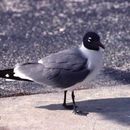fr
noms dans le fil d’Ariane


A medium-sized (16-17 inches) seagull, the Laughing Gull in summer is most easily identified by its dark gray wings with black tips, black head, dark orange legs, and red bill. In winter, this species loses much of the color on its head and bill, becoming dark-billed with a gray smudge on its crown. Young birds are brownish-gray overall, and are often confused with young gulls of other species. Male and female Laughing Gulls are similar to one another in all seasons. The Laughing Gull breeds along the entire Atlantic coast of the United States, along the Gulf coast from Florida to Texas, and in the West Indies. Populations breeding in the northeast are migratory, wintering further south along the coast of the U.S. or in Mexico, Central America, and South America. Populations breeding in warmer areas are generally non-migratory. Laughing Gulls breed on rocky or sandy islands and beaches by lakes, in marshes, and along the coast. Birds breeding in the tropics may nest on mangrove islands. In general, this species utilizes similar kinds of habitats in winter as in summer. Laughing Gulls eat a variety of foods, including crustaceans, fish, carrion, garbage, and, more rarely, bird eggs. Laughing Gulls are most easily seen foraging for food along sandy beaches. In many coastal areas, this is one of the most common “seagulls,” and may be seen foraging for refuse and carrion on the beach, flying over the water and plunging in to catch fish, or floating on the water’s surface while catching fish with its bill. Laughing Gulls are primarily active during the day.
Leucophaeus atricilla
La Mouette atricille (Leucophaeus atricilla) est une espèce d'oiseaux de la famille des Laridae.
Son nom anglais est Laughing Gull mais est différente de la Mouette rieuse d'Europe.
L'adulte en plumage nuptial a le bec et la tête gris sombre à noir avec des anneaux périoculaires blancs, le cou et le dessous du corps blancs, le dos gris foncé et les rémiges noirâtres. En plumage internuptial, la tête est davantage marquée de blanc.
L'immature a la tête blanche et grisâtre tandis que le reste du corps est brunâtre, noirâtre et blanc sale.
Son cri ressemble à un ricanement (d'où son nom anglais).
Cet oiseau vit aux Antilles et sur les côtes est d'Amérique du Nord ; il hiverne en Amérique centrale et les côtes nord-ouest d'Amérique du Sud.
Lors des migrations et en hivernage, cet oiseau fréquente surtout les littoraux mais aussi les grandes rivières.
D'après Alan P. Peterson, cette espèce est constituée des deux sous-espèces suivantes :
Leucophaeus atricilla
La Mouette atricille (Leucophaeus atricilla) est une espèce d'oiseaux de la famille des Laridae.
Son nom anglais est Laughing Gull mais est différente de la Mouette rieuse d'Europe.